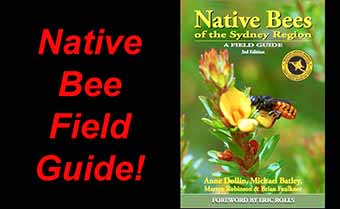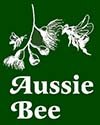PART 3. WHAT BEES WILL USE MY BEE HOTEL?
Aussie Bee > Bee Hotel Guide > Native Bee Visitors
The most interesting part of having a Bee Hotel is watching the insects that use it and working out what they are! A number of different kinds of native bees will use a Bee Hotel, as well as some beneficial wasps and other insects.
The easiest way to identify the native bees in your Bee Hotel is to look at the materials they are using to build and seal their tiny nests.
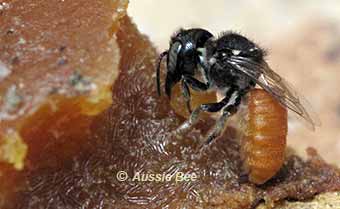
We collected this small block of resinous material from our stingless bee nests and this resin bee is collecting some resin from it to seal her nest entrance.
Here are the most common kinds of native bees that you might see checking into your Bee Hotel:
-- Resin Bees
-- Leafcutter Bees
-- Wasp Mimic Bees
-- Masked Bees
-- Reed Bees
-- Blue Banded Bees
-- Carder Bees
Resin Bees
Resin Bees will nest in drilled holes in timber or in bamboo canes. They sometimes also use the holes that we have poked into our Blue Banded Bee mud bricks.
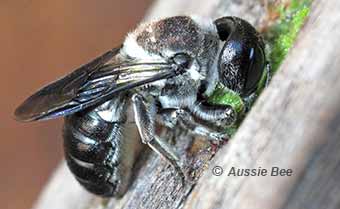
This Big Black Resin Bee (Megachile punctata) is sealing the entrance of her nest in a bee hotel with some resin mixed with chewed leaf material.
Resin Bees collect soft resin oozing from a damaged tree limb and use it to construct cells inside their nests and to seal up the entrance of their finished nest. Sometimes they also pinch some resin from the entrance of our Stingless Bee hives! However, they don't do any harm to the Stingless Bees so we are happy to let them do this.
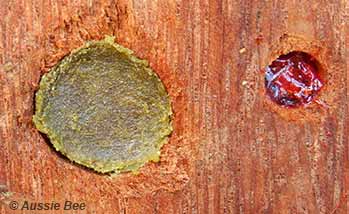
Here are two completed nests made by Resin Bees -- the seal on the left one has chewed leaf material mixed into it, while the one on the right is made from pure tree resin.
Resin Bees range in size from about 6 to 16 mm. Many are black with white fur bands and some have bright orange abdomens. They carry their pollen in a dense pad on bristles underneath the abdomen. Megan Halcroft has produced a downloadable booklet, 'The Bee Hotel ID Guide', that shows some common Resin Bee species that use Bee Hotels.
Leafcutter bees
Leafcutter Bees nest in the drilled holes in timber blocks and in bamboo canes. They cut beautifully-regular circular and oval shaped pieces of soft leaf to construct their nests. You may see their distinctive cut marks in the leaves of rose bushes, buddleja, bauhinia and wisteria in your garden.
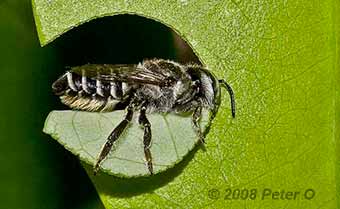
Photographer, Peter O, has managed to capture this leaf cutter bee in the act of snipping out a circle of leaf to use for her nest building.
They curl the leaf piece between their legs underneath their body to carry it back to their nests. They then manoeuvre the leaf piece into the hole and use it to construct individual cells for their young. Finally they seal the nest hole with a series of leaf discs.
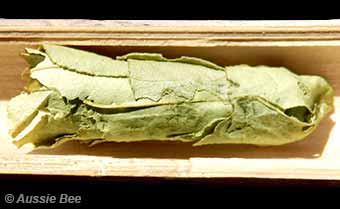
This is a completed nest cell made by a Leafcutter Bee. It contains a ball of pollen and nectar, with a single egg.
Leaf cutter Bees range in size from about 6 to 15 mm. Many are black, with white fur bands, and some have bright orange abdomens. They carry their pollen underneath their abdomen, similar to the way that the Resin Bees do. Megan Halcroft's booklet, 'The Bee Hotel ID Guide', also shows some common Leafcutter Bee species that use Bee Hotels.
Wasp Mimic Bees
Wasp Mimic Bees (Hyleoides concinna) will build nests in drilled timber holes and in bamboo canes. They secrete a cellophane-like material which they use to build cells inside their nest and to seal the nest entrance.
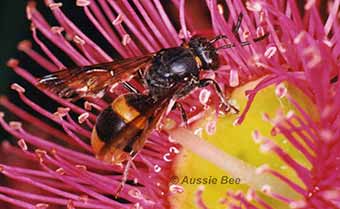
The orange and black stripes of the Wasp Mimic Bee make them look very similar to some kinds of wasps.
Their nests are easy to recognise because they build a unique flexible barrier, made of cellophane strands, across the entrance of their nest hole. The dense network of strands looks like the iris of your eye (see photo). The strands are all cut in the middle, which allows the bee to push her way through the barrier as she enters and leaves her nest. This barrier is kept in place throughout the time that the female is making cells in her nest.
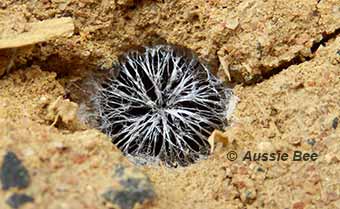
A Wasp Mimic Bee built this delicate springy nest entrance in a tiny hole in a mud brick wall at the Secret Garden in Richmond NSW.
As their name suggests, Wasp Mimic Bees look very much like orange and black wasps. However they are true bees which collect nectar and pollen for their young. They are about 11 to 14 mm long.
Masked Bees
Due to their relatively small size, Masked Bees tend to like the smaller holes in the drilled timber blocks and bamboo tubes.
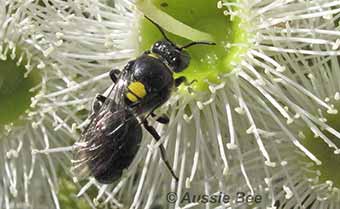
Masked bees are shiny black bees that usually have distinctive yellow markings on their backs and faces.
As in the Wasp Mimic Bees, Masked Bees secrete a cellophane-like material that they use to construct cells inside their nests and also to seal their nest entrance. Unlike the Wasp Mimic Bees, though, the Masked Bees do not seal their nest entrance until the nest is completed. At this stage they build a shiny flat translucent cellophane wall across the end of the nest tube.
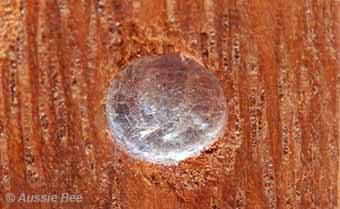
Masked bees seal the entrances of their completed nests with a shiny whitish barrier made from their cellophane-like material.
Most Masked Bees are less than 10 mm long. They are slender black bees, with yellow markings. As their name suggests, most species have distinctive yellow markings on their faces. Many species also have a bright yellow patch on the rear edge of their thorax (middle segment). Masked Bees carry pollen back to their nest by swallowing it.
Reed Bees
Reed Bees cut nest burrows for themselves in pithy stems. So you may find these bees nesting in the cut lantana canes in your Bee Hotel. Reed Bees are semi-social bees so there may be a small group of bees living in the one nest. Often one bee takes on the job of a guard and she blocks the tiny entrance hole of her nest with her abdomen. If you look closely, the bee's abdomen looks like a shiny red or black spot in the nest entrance.
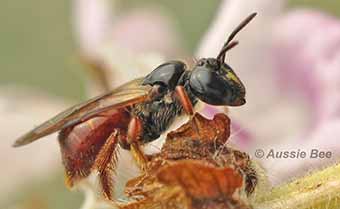
This little Reed Bee has a red abdomen and a small cream patch on her face.
Reed Bees are about 4 to 8 mm long. They are slender black bees, often with a cream marking on the face. Some species have a red abdomen. They carry pollen on their hind legs.
Blue Banded Bees
Blue Banded Bees will dig shallow nest burrows in clay bricks in a Bee Hotel. Each individual bee constructs a set of individual clay cells for her young, at the bottom of her nest burrow.
Bluebanded Bees are about 8 to 13 mm long. They have a dense coat of red-brown fur on their thorax (middle segment). Their abdomen (hind segment) is black, with bands of fur across it that are usually iridescent blue, or whitish. In some species the bands on the abdomen are greenish or brown. They carry pollen on their hind legs.
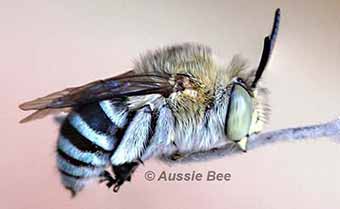
The attractive blue bands of the bluebanded bees can be seen in this male that is roosting at night on a stem.
Male Blue-Banded Bees do not live in the nest burrows. During the day you may see them darting around the nests looking for females. At night they often gather in groups to sleep on a stem or twig.
Carder Bees
Carder Bees are not Australian native bees. They are a feral species from South Africa that was accidentally introduced to Australia in the late 1990s. They have now spread widely in Australia and may be seen from Queensland through to Victoria.
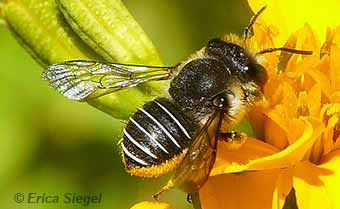
In Erica Siegel's photo of a Carder Bee, the distinctive solid white bands on the abdomen can be seen.
They are quite common in some areas and may be found using Bee Hotels. They build a very distinctive nest that looks like a clump of cotton wool. They gather fine hairs from plant leaves to construct their nest.
Carder Bees look rather like Leafcutter Bees. However, the white stripes across their abdomen are solid bands of colour along the edge of each segment, not bands of fur as in the Leafcutter Bees. They carry pollen underneath their abdomen, just as the Resin Bees and Leafcutter Bees do. They are about 7 mm long.
NEXT: Part 4. What other insects will use my Bee Hotel?
Aussie Bee Guide to Bee Hotels
PART 1. What is a Bee Hotel and how can it help?
PART 2. How do I make a Bee Hotel?
PART 3. What bees will use my Bee Hotel?
PART 4. What other insects will use my Bee Hotel?
PART 5. What should I do about pests and parasites?

